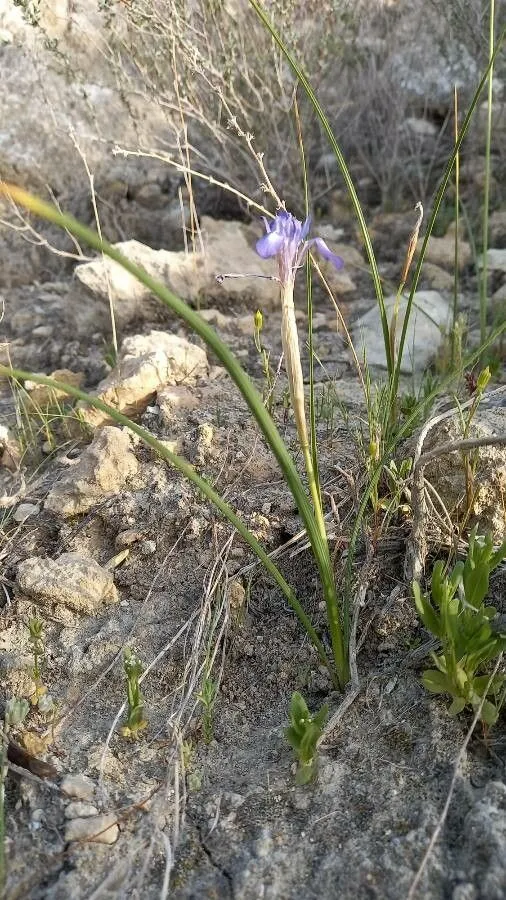
Author: (L.) Ker Gawl.
Bibliography: Ann. Bot. (König & Sims) 1: 241 (1804)
Year: 1804
Status: accepted
Rank: species
Genus: Moraea
Vegetable: False
Observations: Medit. to W. Himalaya and Arabian Pen.
The Barbary nut-iris, scientifically known as Moraea sisyrinchium, is a captivating species belonging to the Iridaceae family. Revered for its delicate beauty, this enchanting plant was first documented in “Ann. Bot.” by König and Sims in 1804 and subsequently established its scientific standing through the work of botanist (L.) Ker Gawl.
Moraea sisyrinchium is native to a broad geographical region that spans the Mediterranean, stretching across to the western Himalayas and encompassing the Arabian Peninsula. This diverse habitat range reflects the plant’s adaptability to various climatic conditions.
Characterized by its striking flowers, the Barbary nut-iris boasts an intricate floral structure with vibrant hues that capture the eye. Each blossom presents a delicate yet striking display, often featuring shades of blue, purple, or yellow. The flowers are typically short-lived, which adds to their ephemeral charm and has inspired botanical enthusiasts and horticulturists alike to cultivate and preserve this species.
The plant’s growth habit involves slender, grass-like leaves and a clump-forming nature, which makes it a suitable addition to garden landscapes, particularly in rock gardens or arid environments where it can thrive with minimal water. Its resilience and adaptability are mirrored in its natural distribution, as it has mastered survival in various terrains from coastal areas to mountainous regions.
Overall, Moraea sisyrinchium, or the Barbary nut-iris, stands out not only for its aesthetic appeal but also for its ecological versatility. This plant continues to captivate botanists and plant lovers with its blend of beauty and hardiness, ensuring its presence in both wild and cultivated landscapes.
Swe: knöliris
En: Barbary Nut-iris, Spanish Nut-iris
Ar: خيطه (خِيطه)
Ca: Lliri sisirinqui
Fr: Iris faux sisyrhinque, Iris sisyrhinque
De: Mittags-Schwertlilie
It: Castagnole, Giaggiolo dei poveretti, Giglio dei poveretti
Es: Mazuca, Patita de burro
Sv: Knöliris
: Barbary nut-iris
Taken Apr 17, 2021 by Eloísa Romero (cc-by-sa)
Taken Mar 1, 2020 by Manuel Sánchez (cc-by-sa)
Taken Feb 22, 2020 by fabrice bloch (cc-by-sa)
Taken Sep 28, 2021 by César Gonzalez (cc-by-sa)
Taken Mar 4, 2021 by Lucia Sanchez (cc-by-sa)
Taken Mar 30, 2022 by Jean Burger (cc-by-sa)
Taken Mar 20, 2021 by Prieta Javier (cc-by-sa)
Taken Mar 27, 2021 by Miguel A. C. (cc-by-sa)
Taken Feb 25, 2021 by Catherine David (cc-by-sa)
Taken Mar 17, 2022 by Abdul Ghaffar (cc-by-sa)
Taken Apr 19, 1998 by Tela Botanica − Liliane Roubaudi (cc-by-sa)
Taken Apr 10, 2016 by Tela Botanica − Patrick LEBOULENGER (cc-by-sa)
Taken May 6, 2012 by Tela Botanica − Patrick LEBOULENGER (cc-by-sa)
Taken Feb 24, 2013 by Tela Botanica − Hugues Sauvage (cc-by-sa)
Taken Mar 17, 2022 by Abdul Ghaffar (cc-by-sa)
Taken Mar 30, 2022 by Jean Burger (cc-by-sa)
Taken Mar 7, 2020 by Xeve Dor (cc-by-sa)
Taken Mar 30, 2019 by Bouharaoua BOUDANI (cc-by-sa)
Taken Mar 8, 2021 by zeev zeev (cc-by-sa)
Taken Mar 17, 2022 by Abdul Ghaffar (cc-by-sa)
Taken Sep 12, 2022 by M. Hedayat (cc-by-sa)
Taken Feb 15, 2007 by Photoflora – Benoit BOCK (©)
Taken Mar 15, 2018 by Photoflora – Benoit BOCK (©)
Taken Jan 1, 1970 by Photoflora – L’Abbé COSTE (©)
Taken Apr 15, 2009 by Photoflora – Benoit BOCK (©)
© copyright of the Board of Trustees of the Royal Botanic Gardens, Kew.
© copyright of the Board of Trustees of the Royal Botanic Gardens, Kew.
© copyright of the Board of Trustees of the Royal Botanic Gardens, Kew.
Ph maximum: 8.0
Ph minimum: 7.5
Light: 8
Atmospheric humidity: 3
Bloom months: [‘apr’, ‘may’]
Soil nutriments: 5
Family: Myrtaceae Author: (F.Muell.) K.D.Hill & L.A.S.Johnson Bibliography: Telopea 6: 402 (1995) Year: 1995 Status:…
Family: Rubiaceae Author: Pierre ex A.Froehner Bibliography: Notizbl. Bot. Gart. Berlin-Dahlem 1: 237 (1897) Year:…
Family: Sapindaceae Author: Koidz. Bibliography: J. Coll. Sci. Imp. Univ. Tokyo 32(1): 38 (1911) Year:…
Family: Asteraceae Author: A.Gray Bibliography: Pacif. Railr. Rep.: 107 (1857) Year: 1857 Status: accepted Rank:…
Family: Fabaceae Author: Medik. Bibliography: Vorles. Churpfälz. Phys.-Ökon. Ges. 2: 398 (1787) Year: 1787 Status:…
Family: Aspleniaceae Author: (Cav.) Alston Bibliography: Bull. Misc. Inform. Kew 1932: 309 (1932) Year: 1932…